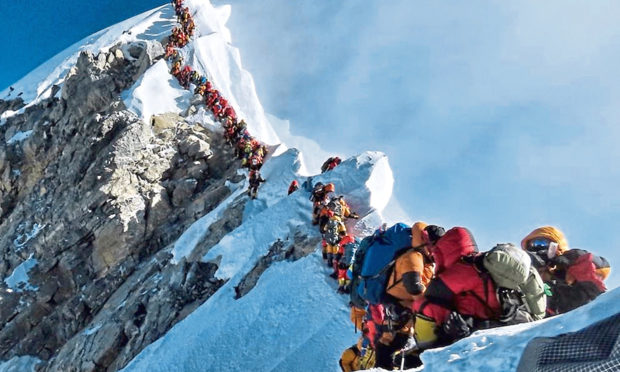I dream of Everest. Who doesn’t who loves mountains? It first caught my imagination the day the radio announced it had been climbed, June 2 1953. I have followed the mountain’s fortunes ever since. I was not quite six. They held the announcement back to coincide with the coronation. I didn’t care about the coronation.
This was, after all, the only place on Earth where, truly, you could feel on top of the world – why wouldn’t you want to know how that feels?
Today, one answer to that question is: “Because it’s killing the mountain.”
Do you remember the photograph in May 2019 of a kind of linear gridlock of hundreds of climbers on the summit ridge? It caused global headlines, and prompted the climbing world – and a fair bit of the non-climbing world for that matter – to ponder the effects of what mountaineering has done to the top of the world.
My heart turned over at the sight. I seethed, which is a thing I do very rarely. But this is not a new controversy to me. And as one who loves mountains, its symbolism is huge.
Choked with rubbish
So what brought this on again? I just read a newspaper story which began with one of journalism’s unlikelier sentences: “Rubbish collected from Mount Everest is to be transformed into art and displayed in a nearby gallery to highlight the need to save the world’s tallest mountain from turning into a dumping site.”
Yes, that ought to do it. Thousands of oxygen bottles, tents, ropes, cans, plastic wrappers and much else besides are routinely dumped. A gallery at Syangboche on the main trail to Everest base camp will display “artwork to raise environmental awareness”.
I have a better idea. Close the mountain.
The Sherpas don’t say “Everest”, they say Sagamartha which means “Mother of the Universe”; the Tibetans say Chomolungma, “Goddess Mother of the Wind”. The people who have lived closest to Everest for thousands of years consider it sacred. Colonial Britain named it Everest in 1865 in honour of a prominent figure in Himalayan geographical survey work. The name stuck. It sticks still.
A High and Lonely Place
I have form in all this, among which is an article I wrote for the New Statesman in the face of one more outrage against the mountain in the mid 1990s. By then I had written A High and Lonely Place and Among Mountains, both of which were short-listed for the Boardman-Tasker Prize for Mountain literature, so the article carried a little more heft than it might otherwise have done.
I argued that the mountain should be closed to all expeditions forever, apart from one last international effort to clean it, once and for all, of rubbish and dead bodies. Then it should be allowed to heal and to remain an inviolate, sacred mountain. The argument fell on a lot of deaf ears, but it attracted the attention of one remarkable ally.
When A High and Lonely Place was published in London in 1990, its editor Tony Colwell told me about an extraordinary mountaineering book he had also been working on, and which was hot off the press. As I was leaving his office, he handed me a copy. It was Touching the Void by Joe Simpson. In 1997, Joe Simpson wrote Dark Shadows Falling, a book about eroding ethical standards in mountaineering.
‘Calls for a complete ban’
He wrote: “There have been calls for a complete ban on climbing Everest, citing the plausible argument there is nothing left to be proved by an ascent other than to massage the egos of rich clients whose motives leave a lot to be desired.”
I read that, nodding my agreement, but then, quite unexpectedly, there was this: “Everest… is now no more than ‘an old whore made sordid and debauched by her clientele,” according to Jim Crumley, the author of Among Mountains. Crumley might well have a point when he wrote in the New Statesman that ‘ego massage for the rich is not justification enough for what Everest climbing has become’.
“I can sympathise with Crumley’s view that it is time for Everest to be made inviolate, closed to all suitors for all time, to become a sanctuary to be honoured, admired and respected rather than abused for profit.
“‘It will take the marshalling of world opinion,’ Crumley writes, ‘but to restore Everest’s sanctity should be as high a priority of nature conservation as saving the tiger.’ If he is correct, then it is a frightening analogy, given that the tiger, despite all international efforts at conservation, is today on the verge of extinction.”
The tiger may be saved, Everest may not
The tiger may yet be saved. The world cares about it. Everest lurches nearer to the abyss and the world does not care. An art gallery?
I still dream of Everest, but the dream is different now. I am always standing alone on the summit, looking not at the view of the world but at the sky.
A skein of bar-headed geese are migrating 1,000 feet higher than the summit. Without Sherpas or oxygen.
And I always say the same thing: “What am I doing here?”










